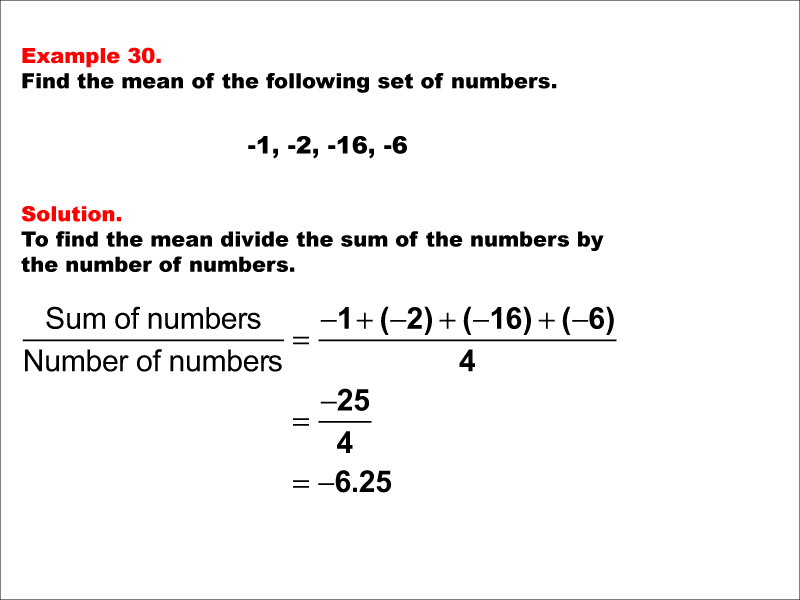
Display Title
Math Example--Measures of Central Tendency--Mean: Example 30
Display Title
Math Example--Measures of Central Tendency--Mean: Example 30

Topic
Measures of Central Tendency
Description
This example demonstrates the calculation of the mean for the numbers -1, -2, -16, and -6. The process involves summing all values (-25) and dividing by the count of numbers (4), resulting in a mean of -6.25. This example is particularly instructive as it shows how to handle a dataset consisting entirely of negative numbers, including one significantly larger negative value, in the calculation of the mean.
Understanding measures of central tendency, particularly the mean, is crucial in statistics and data analysis. These measures provide a way to summarize large amounts of data into a single, representative value, allowing for quick comparisons and insights. Mastering these concepts, especially when dealing with datasets that include only negative numbers of varying magnitudes, enables students to interpret data effectively and make informed decisions in various fields of study.
The presentation of multiple examples, especially those with negative numbers of different magnitudes, is key to solidifying students' grasp of the mean concept. Each new example, while following the same basic process, presents a unique set of numbers with different characteristics. This repetition with variation helps students recognize the underlying principles and develop the flexibility to apply the concept across diverse situations, including those where all values are below zero.
Teacher Script: "Let's examine our thirtieth example of calculating the mean. Notice how our dataset includes only negative numbers, with one significantly larger negative value (-16). As we work through this, consider how these negative values, especially the larger one, affect our final result. The mean of -6.25 is negative, which is expected given our dataset, but it's not as negative as the largest value in the set. This example illustrates an important point: the mean provides a balance of all values in a dataset, even when they're all negative. In real-world scenarios, you might encounter data like this when analyzing losses, decreases, or measurements below a baseline. Remember, interpreting negative means requires careful consideration of the context."
For a complete collection of math examples related to Measures of Central Tendency click on this link: Math Examples: Measures of Central Tendency: Mean Collection.
| Common Core Standards | CCSS.MATH.CONTENT.6.SP.B.4, CCSS.MATH.CONTENT.6.SP.A.3, CCSS.MATH.CONTENT.HSS.ID.A.2, CCSS.MATH.CONTENT.HSS.ID.A.3 |
|---|---|
| Grade Range | 6 - 12 |
| Curriculum Nodes |
Algebra • Probability and Data Analysis • Data Analysis |
| Copyright Year | 2014 |
| Keywords | data analysis, tutorials, measures of central tendency, mean, average |